![]()
![]()
![]()
Use LEFT and RIGHT arrow keys to navigate between flashcards;
Use UP and DOWN arrow keys to flip the card;
H to show hint;
A reads text to speech;
69 Cards in this Set
- Front
- Back
|
canals function in paired sets |
right anterior (superior) and left posterior (inferior) right posterior (inferior) and left anterior (superior) right horizontal and left horizontal |
|
|
The VOR is generated in response to __. |
acceleration |
|
|
the neural integrator |
converts neural signals proportional to acceleration into velocity signals used for the VOR |
|
|
categories of rotational testing |
passive rotation (patients entire body is rotated) active rotation (patient voluntarily moves head) |
|
|
rotary chair components |
enclosure chair head restraint infrared oculography optokinetic drum |
|
|
advantages od performing oculomotor testing in the rotational chair enclosure |
|
|
|
components of oculomotor testing |
spontaneous nystagmus gaze evoked nystagmus random saccades horizontal smooth pursuit optokinetic testing |
|
|
What should be performed first for interpretation? |
evaluation of gaze and/or spontaneous nystagmus |
|
|
rotational test paradigms |
sinusoidal rotation test (VOR, VVOR, Fixation)
velocity step test |
|
|
positioning for rotational testing |
|
|
|
components of sinusoidal harmonic acceleration test |
VOR vs frequency VVOR VOR fixation |
|
|
What is the most widely used rotational test? |
sinusoidal harmonic acceleration |
|
|
sinusoidal harmonic acceleration |
rotation around central axis
in either direction in a variety of speeds (frequencies) |
|
|
frequencies tested for SHA |
harmonics (multiples of each other)
each frequency is doubled the speed of the previous frequency |
|
|
clinical measures for SHA |
gain phase symmetry |
|
|
peak angular velocity for SHA |
60 degrees per second |
|
|
SHA note |
tasking is very important
make sure patient is alter and responsive throughout testing |
|
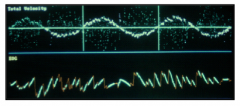
|
SHA example data |
|
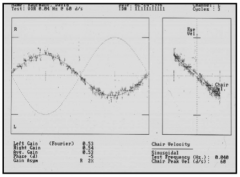
|
SHA example data |
|
|
VOR gain |
amplitude of head movement compared to the amplitude eye movement |
|
|
abnormalities of VOR gain |
abnormal if 2 consecutive frequencies are out of normal range
reduced gain
excessiv e gain
|
|
|
VOR phase |
timing of head movement compared to eye movement
"timing" relation between head motion and vestibular response |
|
|
what is phase reported in |
negative values called "phase leads" |
|
|
abnormalities of VOR phase |
|
|
|
VOR symmetry responses to |
rightward and leftward stimulation
should be around 0 |
|
|
abnormalities of VOR asymmetry |
|
|
|
abnormalities of VOR |
|
|
|
vestibular fixation test |
|
|
|
How is VFX measured? |
in terms of
|
|

|
VFX results summary |
|
|
VFX interpretation evaluates ENS ability to... |
suppress VOR with fixation (like VNG testing) |
|
|
excessive gain in VFX demonstrates... |
failure of fixation suppression suggesting potential for cerebellar dysfunction |
|
|
visual-vestibular ocular reflex (VVOR) procedure |
patient is rotated around central axis with OPK lights stationary at 0.04 and 0.08 Hz at 60 degrees per second |
|
|
vvor is an interaction between |
visual and vestibular mechanisms |
|
|
What does patient use to track during vvor? |
combination of VOR and visual pursuit |
|
|
what is vvor useful for diagnosing? |
peripheral vs central disorders |
|
|
What is indicated for patients with decreased gain in SHA testing and a normal vvor score? |
they are able to compensate for vestibular loss with a voluntary pursuit |
|
|
what should vvor be if vestibular system is compromised but oculomotor system is normal? |
vvor should be normal (nystagmus should be present) |
|

|
vvor interpretation |
|
|
normal vvor gain |
0.8 - 1.0 |
|
|
What would decreased vvor gain suggest? |
maybe a brainstem involvement (in conjunction with normal vor) |
|
|
What is increased vvor gain suggestive of? |
cerebellar involvement
note: patients with cerebellar lesions often exhibit normal VOR and OKN gains |
|
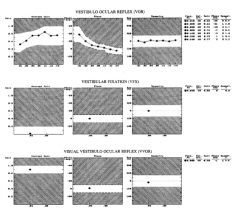
|
SHA results summary |
|
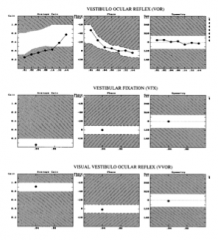
|
abnormal sha results summary |
|
|
step velocity test |
impulse rotation sustained in one direction for ~45 seconds - chair is then abruptly stopped
patient rotated around central axis in clockwise and counterclockwise directions at 100 degrees per second |
|
|
what does step velocity test measure? |
gain time constant |
|
|
step velocity test...should there be nystagmus? |
yes, produced by acceleration |
|
|
what component of nystagmus is recorded for step velocity test? |
slow component |
|
|
What will happen after a period of sustained rotation with step velocity test? |
intensity of nystagmus will reduce |
|
|
time constant |
the time needed for the nystagmus to decreased to 30% of its maximum SPV |
|
|
what anatomical things are examined during step velocity test? |
the response of the horizontal canal and the velocity storage mechanism |
|
|
what is the velocity storage mechanism? |
a continuation of the neural response after the vestibular labyrinth stops responding |
|
|
nystagmus during step velocity test |
decreases more after the period of the time constant
stops completely before the end of the 4 sec rotation |
|
|
cupula time constant in humans |
4 - 7 seconds |
|
|
what does the preservation of nystagmus occur for? |
central velocity storage |
|
|
abnormal for time constant |
peak SPV of 60 degrees/second isles than 10 seconds |
|
|
abnormalities of VOR time constant |
unilateral weakness bilateral weakness |
|
|
unilateral weakness |
reduced gain and time constants for rotations ipsilateral to pathology |
|
|
bilateral weakness |
reduced gain and time constants in both clockwise and counterclockwise directions |
|
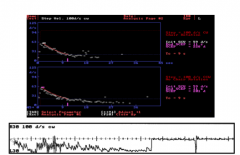
|
velocity step test |
|
|
advantages of rotational testing |
|
|
|
disadvantages of rotational testing |
|
|
|
adaptions for rotational tests for children |
|
|
|
advanced rotational tests |
autorotation test (VAT or VORTEQ)
head-shake test |
|
|
active rotational test procedure |
|
|
|
advantages of rotary chair testing for active rotational test |
|
|
|
frequency for active rotation test |
0.5 to 8 hz |
|
|
measures for active rotation test |
gain phase symmetry |
|
|
potential problems for active rotational testing |
influence of the cervico-ocular reflex
slippage of the sensory band and electrode movement in vigorous head shake |

